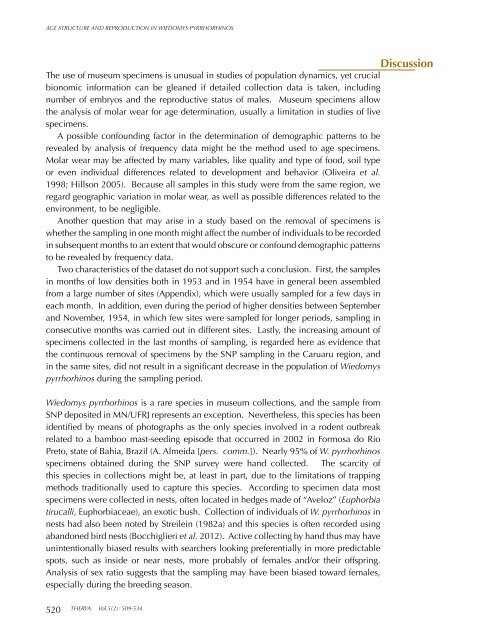therya-5_2
therya-5_2
therya-5_2
Create successful ePaper yourself
Turn your PDF publications into a flip-book with our unique Google optimized e-Paper software.
AGE STRUCTURE AND REPRODUCTION IN WIEDOMYS PYRRHORHINOS<br />
The use of museum specimens is unusual in studies of population dynamics, yet crucial<br />
bionomic information can be gleaned if detailed collection data is taken, including<br />
number of embryos and the reproductive status of males. Museum specimens allow<br />
the analysis of molar wear for age determination, usually a limitation in studies of live<br />
specimens.<br />
A possible confounding factor in the determination of demographic patterns to be<br />
revealed by analysis of frequency data might be the method used to age specimens.<br />
Molar wear may be affected by many variables, like quality and type of food, soil type<br />
or even individual differences related to development and behavior (Oliveira et al.<br />
1998; Hillson 2005). Because all samples in this study were from the same region, we<br />
regard geographic variation in molar wear, as well as possible differences related to the<br />
environment, to be negligible.<br />
Another question that may arise in a study based on the removal of specimens is<br />
whether the sampling in one month might affect the number of individuals to be recorded<br />
in subsequent months to an extent that would obscure or confound demographic patterns<br />
to be revealed by frequency data.<br />
Two characteristics of the dataset do not support such a conclusion. First, the samples<br />
in months of low densities both in 1953 and in 1954 have in general been assembled<br />
from a large number of sites (Appendix), which were usually sampled for a few days in<br />
each month. In addition, even during the period of higher densities between September<br />
and November, 1954, in which few sites were sampled for longer periods, sampling in<br />
consecutive months was carried out in different sites. Lastly, the increasing amount of<br />
specimens collected in the last months of sampling, is regarded here as evidence that<br />
the continuous removal of specimens by the SNP sampling in the Caruaru region, and<br />
in the same sites, did not result in a significant decrease in the population of Wiedomys<br />
pyrrhorhinos during the sampling period.<br />
Wiedomys pyrrhorhinos is a rare species in museum collections, and the sample from<br />
SNP deposited in MN/UFRJ represents an exception. Nevertheless, this species has been<br />
identified by means of photographs as the only species involved in a rodent outbreak<br />
related to a bamboo mast-seeding episode that occurred in 2002 in Formosa do Rio<br />
Preto, state of Bahia, Brazil (A. Almeida [pers. comm.]). Nearly 95% of W. pyrrhorhinos<br />
specimens obtained during the SNP survey were hand collected. The scarcity of<br />
this species in collections might be, at least in part, due to the limitations of trapping<br />
methods traditionally used to capture this species. According to specimen data most<br />
specimens were collected in nests, often located in hedges made of “Aveloz” (Euphorbia<br />
tirucalli, Euphorbiaceae), an exotic bush. Collection of individuals of W. pyrrhorhinos in<br />
nests had also been noted by Streilein (1982a) and this species is often recorded using<br />
abandoned bird nests (Bocchiglieri et al. 2012). Active collecting by hand thus may have<br />
unintentionally biased results with searchers looking preferentially in more predictable<br />
spots, such as inside or near nests, more probably of females and/or their offspring.<br />
Analysis of sex ratio suggests that the sampling may have been biased toward females,<br />
especially during the breeding season.<br />
Discussion<br />
520<br />
THERYA Vol.5(2): 509-534



